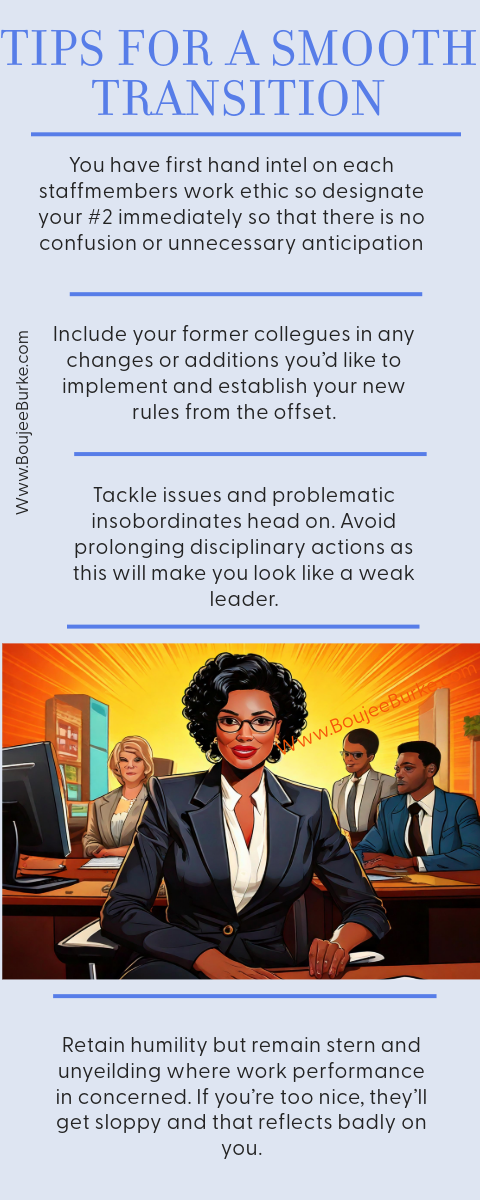Movin' On Up! Getting A Promotion Over Your Co-Workers. . .
Making your managerial promotion as easy and as swift as possible for all parties involved. From making subtle changes to tackling drastic measures; get new insight on how to deal with such issues from the perspective of someone whose been on both sides of the fence.
PROMOTIONSNEW JOBWORKPLACECAREERMANAGERIALINSUBORDINATE
Illya Burke
2/18/20254 min read
Success and Triumph: When Hard Work Finally Pays Off
It’s not every day that dedication and perseverance actually lead to tangible rewards, but when they do, it’s a moment worth savoring. For years, I put in the effort, stayed late, and outperformed expectations; while some of my coworkers took shortcuts or played politics, I remained steadfast. And now, the tables have turned—I’ve been promoted, and I find myself in a position to supervise some of the very people who once dismissed me. Ha!
Navigating this transition isn’t just about basking in the glory of my hard-earned success—it’s about strategically managing former peers who may not be thrilled with my new role. According to experts, moving from coworker to boss is tricky. Resentment, passive resistance, and outright hostility can surface, making leadership even more challenging. Some will openly push back against authority, while others might sabotage progress in subtle ways so pay attention to little details.
Rather than letting these dynamics derail my success, I am rising up to the challenge, baby! Key strategies from leadership consultants suggest acknowledging the change openly, setting clear expectations, and maintaining a professional, objective stance. This isn't my first rodeo so i already know my leadership style will be defined by fairness, accountability, and a firm boundary between friendship and professional responsibility.
Still, I’d be lying if I said I don’t enjoy the irony. Those who once dismissed my abilities now have no choice but to acknowledge them. The satisfaction of proving doubters wrong is a powerful motivator, but the true victory lies in leading effectively despite the undercurrents of resentment. They can glare at me in frustration all they want, but that won't stop me from wearing my success with pride. In fact, haters make my day!
As I move forward, I recognize that leadership is about more than personal vindication. It’s about setting a precedent, fostering growth, and ensuring that my own success translates into a well-managed and productive team. And that, is one the sweetest triumphs. And now, we address the scowls. . .
Every workplace has them—the insubordinate, the disruptive, the productivity killers who somehow manage to skirt by despite their glaring flaws. Maybe they were hired before you took over. Maybe they used to be good but have turned into morale-draining parasites. Regardless, their continued presence is a cancer to your team, your bottom line, and your sanity. So how do you cut them loose—quickly, aggressively, and most importantly, legally?
Step 1: Documentation is Your Sword and Shield
A time-tested motto/method comes in to play here. CYA! Cover your ass! Before swinging the termination axe, you need an airtight case. Keep records of misconduct, insubordination, missed deadlines, and any behaviors that violate company policy. Without solid documentation, you’re handing them ammo for a wrongful termination lawsuit.


Refer to Business Management Daily’s insubordination guide for clear definitions and strategies on handling defiant employees. If their behavior fits the mold, start building your file immediately.
Step 2: Enforce the Rules—Selectively and Strategically
Not all infractions are equal. Use selective enforcement as a tool—focus on consistent problem areas that provide clear legal standing for termination. If lateness is an issue, crack down on it company-wide, but ensure the problematic employee is the biggest offender. If it's insubordination, make sure they’re consistently pushing back against reasonable requests.
Step 3: Cut Off Their Escape Routes
Problem employees often cry foul, claiming unfair treatment. Neutralize this by ensuring they can’t claim discrimination or retaliation. Stick to performance-based justifications, align their infractions with company policies, and, when possible, have witnesses or written communication backing up your actions.
Step 4: The Performance Improvement Plan (PIP) Trap
If you want to make the process bulletproof, slap them with a PIP. This is your Trojan horse—disguised as a second chance, but really a well-structured path to termination. Make the goals strict but attainable, so when they inevitably fail (because they always do), you have a clean, documented reason to show them the door.
Step 5: The Final Swing—Termination Done Right
When it's time to drop the hammer, do it decisively and expeditiously. Keep the confrontation short, stick to the facts, and have HR present. If you expect resistance, have security on standby. Do not get emotional or engage in drawn-out debates—this is a business decision, not a therapy session. So, if the soon-to-be-ex employee starts to get loud, simply state: "I know this is upsetting, but the decision has been finalized. There's no option for discussion, we must part ways. Please gather your personal items and exit the premises."
Step Lock It Down Post-Termination
The moment they’re out, disable all access—emails, badges, system logins. Expect a backlash, whether it’s gossip, social media rants, or even legal threats. Stay professional, keep your records intact, and let your legal team handle any noise but do not allow the recoil to deter you from cracking the proverbial whip.
The Takeaway:
Getting rid of bad employees isn't just about firing them—it's about setting the stage so that when you do, they have no ground to fight back. Be strategic, be ruthless, and above all, be legally bulletproof. Because in the end, your company is better off without them.
The Culling: How to Aggressively and Legally Remove Problematic Employees:
Acknowledgment https://www.indeed.com/career-advice/career-development/managing-former-peers?utm_campaign=earnedsocial%3Acareerguide%3Asharedirectshare%3AUS&utm_content=How%20To%20Manage%20Former%20Peers%20and%20Why%20It%20Matters%20%28With%20Tips%29&utm_medium=social&utm_source=directshare https://www.odgersberndtson.com/en-us/insights/managing-your-former-peers-after-you-ve-been-promoted-it-s-trickier-than-you-think/ https://cruciallearning.com/blog/what-to-do-when-you-think-a-coworker-resents-your-promotion/ https://www.forbes.com/sites/markmurphy/2015/02/19/you-got-promoted-to-manager-and-a-coworker-is-mad-heres-what-to-say/


